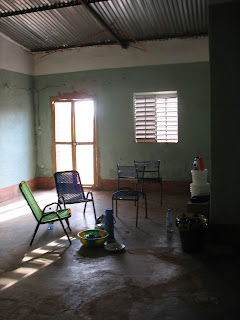Welcome to our house! These pictures are all from when we first arrived at our site. There was NOTHING inside the house--apparently the previous volunteer (who we have heard horror stories about, even from the Malians) gave away everything in the house when she ET'd ("early termination", or quitting), including stuff that wasn't hers to give away, like the Mayor's chairs! Anyway, this is what we started with. We bought the two chairs to the left, but the ones to the right are the Mayor's.
Here's the inside of our house. We have 4 rooms, the big room seen above, and a negen in our house. The door to the very back is the "negen," just a little shower area, which basically means it's 4 walls and a drainage hole that sort of leads water outside. It tends to not drain very well, but it's warmer than showering outside during cold season! The room with the open door is our bedroom--you can see our bug hut in there. (We've replaced the bug hut with a mosquito net since we had a bedframe made.) To the far left is our storage room. The paler door up front is a huge room we don't know what to do with yet. It's empty. And not shown is our kitchen room. This house is bigger than anything we've lived in in America!!
Here is our awesome gwa. There is no real English equivalent for this amazing Malian invention. Later we will have a blog post on Malian things we love, and the gwa is one of them. It provides shade, so it's literally about 10 degrees cooler under the gwa than outside of it. We sit under it, do our laundry under it, sometimes cook under it, and when it's too hot to sleep inside, we even sleep under it! It also hosts our solar panels up top for charging the little lamps Peace Corps gave us. We love our gwa!!
Here is our robinet (from French) that provides all our water. We don't have a well in our compound, just this single spigot--but with it we fill all of our buckets for drinking, cooking, bathing, laundry, you name it. We also wash our hands here, hence the soap. We spend a lot of time standing next to this thing.
Here's the gate to our compound (or du). It locks and can also be shut in a way that makes it difficult for small children to open it--which is ideal! The kids love to poke their heads in and just kind of stare at us, or giggle at us, which gets really old really fast. They also love to play in our trash and compost...so we keep our gate shut quite a lot.
Here are our outdoor negens and on the far right, the door to our tobilikeyoro, or the place for cooking. The tobilikeyoro is kind of haunted looking inside, because it's where people used charcoal for cooking, so it's all smoked out and burnt inside which makes it look scary. We keep our chicken and compost in there now. The negen on the left is a shower one--again, just a drainage hole and walls--and the one on the right has our latrine.
So, here is our negen, which in Bambara just means toilet/shower area. Fortunately for us we have separate spaces for both tasks! So you might be thinking, wow, you have a chimney on your negen! Don't people usually squat over a hole? Why yes, they do. See, the previous volunteer was about 60 and complained to Peace Corps about not having a toilet and having to squat. (Apparently what she really wanted was a flush toilet and plumbing and everything...) The solution was to build this crazy chimney on top of the latrine hole, so she didn't have to squat. It's awkward and strange--do you sit? Do you stand on top of it to squat? We probably stand on top of it more often than we sit on it, but we may end up just demolishing it and returning to the normal hole in the ground. If you have suggestions, we would love to hear them.
This is the space between our house and the neighbors' house. We were thinking of planting a garden back here, but since we have a chicken, it would get demolished. So for now, there is nothing back there. In the foreground you can see our neighbors' soak pit cover. A soak pit is an indigenous solution to wastewater from the negen, which is that small, high window next to their soak pit. You pretty much dig a huge hole and fill it with sand, gravel, and big rocks so that it filters the water before going back into the water table.
Here is the inside of our house--and our dining room table! We had an eating table with two chairs, two big kitchen counters, and a bedframe made by a local carpenter for the small fortune of 100,000 CFA, roughly $200. Wood here is really expensive, so we got a move-in allowance to cover costs like that.
You can also see that we have electricity now! That light illuminates our big giant room, and we have other lights outside, in our kitchen, in the bedroom, and in the big empty room we don't know what to do with. We had to bother the electricity people a lot for the first few weeks, since there was a shortage of counters to measure how much you're using. We had to buy the counter and pay for the installation ourselves, and we only have electricity from 6pm to 1am, but it's such a huge improvement! Compared to other volunteers, who have no electricity or running water, we are living it up at our site.









No comments:
Post a Comment